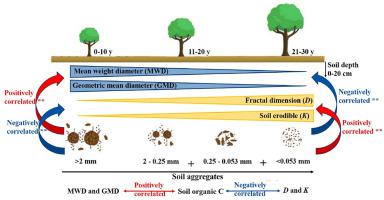Journal of Environmental Management ( IF 8.0 ) Pub Date : 2021-05-27 , DOI: 10.1016/j.jenvman.2021.112847 Sheng Cao 1 , Yuzhou Zhou 1 , Yaoyu Zhou 1 , Xuan Zhou 2 , Weijun Zhou 1

|
Soil aggregates and their associated C may serve as accurate diagnostic markers for changes in soil characteristics in response to different agricultural management practices. However, there is limited knowledge regarding the effects of various chronosequences on soil organic C (SOC) pool in aggregates of different particle sizes in citrus plantations. Surface soil (0–20 cm) samples were collected from 120 citrus orchards (Yongxing County, Hunan Province, China) of different plantation ages (0-10y, 11-20y, and 21-30y). Plantation age dramatically affected the composition of soil aggregates of different particle sizes and their associated SOC, with the strongest macroaggregate fraction observed in the 0-10y orchards. Soil mean weight diameter (MWD) and geometric mean diameter (GMD) gradually decreased with plantation age (by 12.58% and 20.30% in 21–30y orchards, respectively). However, soil fractal dimension (D) and erodibility (K) gradually increased with plantation age (by 3.95% and 2.15% in 21–30y orchards, respectively). Furthermore, the SOC content and pool of aggregates and contribution of aggregates to SOC decreased with decreasing particle size. Multivariate analysis identified the aggregate fraction with a particle size over 2 mm as the main factor affecting the stability of soil aggregates in citrus plantations. The SOC content of aggregates was positively correlated with soil MWD and GMD but negatively correlated with soil D and K. The distribution of organic matter in soil aggregates can help us better understand the stability of soil structure and reduce the risk of soil erosion in successive citrus planting (<30y).

































 京公网安备 11010802027423号
京公网安备 11010802027423号